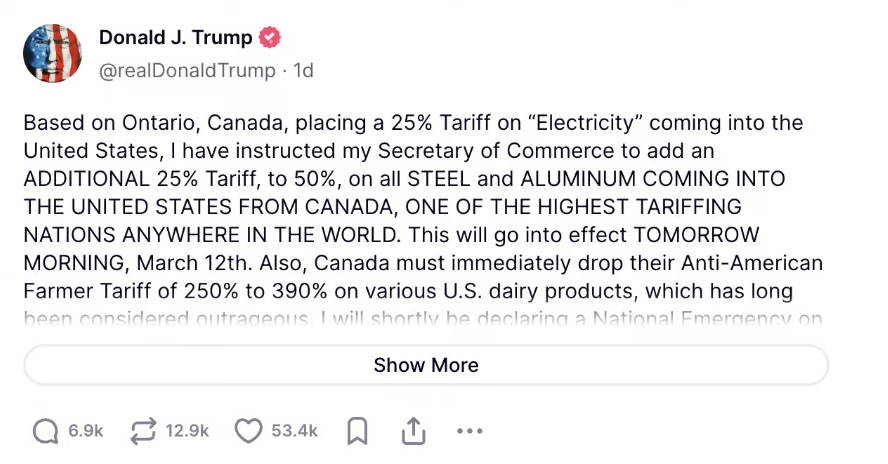An Electrifying Standoff: Power Plays and Steel Determination in Trade War
What has President Trump said this week?
〰️
What has President Trump said this week? 〰️
1. Transition, Not Recession
On Sunday, March 9, President Trump addressed concerns about a potential recession, stating, “There is a period of transition, because what we’re doing is very big. We’re bringing wealth back to America. That’s a big thing. ... It takes a little time, but I think it should be great for us.” His optimism contrasts with recent market signals, which have wiped out over $3 trillion in market value since the day after the election, reflecting investors’ growing concerns and increasing economic uncertainty (Bloomberg, 2025).
The ongoing trade war with the U.S.'s primary trading partners has heightened recession risks, making an economic slowdown more likely than it was just weeks ago (Axios, 2025). According to J.P. Morgan, the probability of a recession stands at 40% if governance instability continues (Reuters, 2025).
Despite these concerns, key administration officials remain confident. Treasury Secretary Scott Bessent described the current economic climate as a necessary “detox period.” Meanwhile, Commerce Secretary Howard Lutnick dismissed recession fears, asserting, “There’s going to be no recession in America. I would never bet on a recession. No chance” (Axios, 2025).
2. Rising Tariffs: From 25% to 50%
No one ever knows which side of the bed President Trump will wake up on—or how it will affect tariffs that day. After delaying tariffs on Mexican and Canadian products for another month, Ontario, Canada, retaliated by imposing a 25% tariff on electricity exports to the U.S., warning of potential further increases or even a complete cutoff. In response, President Trump instructed the Commerce Secretary to raise tariffs on Canadian steel and aluminum to 50%.
However, just hours later, White House trade advisor Peter Navarro told CNBC that the proposed tariff hikes would not go into effect. The uncertainty surrounding these decisions has further strained U.S.-Canada trade relations. The U.S. imports 6.6 million tons of steel and 3.5 million tons of aluminum from Canada annually, making these materials critical to key industries. The ongoing tariff fluctuations have disrupted supply chains, created economic uncertainty, and added tension to the already fragile bilateral relationship.
3. Canada as the 51st State?
President Trump has long floated the idea of annexing Canada as the U.S.’s 51st state, a notion he has reiterated even more forcefully amid escalating trade tensions. Following the latest tariff hike on Canadian steel and aluminum, Trump declared, “The artificial line of separation drawn many years ago will finally disappear, and we will have the safest and most beautiful Nation anywhere in the World.” (Truth, Donald Trump).
Initially dismissing the proposal as absurd, Canadian Prime Minister Justin Trudeau later acknowledged that it had gained enough traction to be considered “a real thing”—before making his stance unequivocally clear: “Not a snowball’s chance in hell.” (BBC, 2025). Last month, Trudeau accused Trump of using tariffs as a deliberate strategy to cripple the Canadian economy, making annexation seem like a more viable option (NYT, 2025).
Despite the rhetoric, annexing Canada would require a series of complex legal and political maneuvers. The U.S. Senate would have to approve it, along with addressing legislative processes like assigning congressional representation and Senate seats. More importantly, Canada would need to gauge public interest in such a move—a scenario that, for now, seems firmly off the table (AP, 2025).


